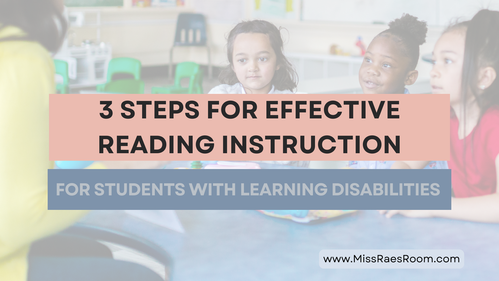|
Enhancing Phonological Awareness in Students with Learning Disabilities: Effective Strategies for Reading Development. Discover key techniques for building phonological awareness skills in students with learning disabilities. From rhyming activities to sound segmentation exercises, explore practical strategies to strengthen phonemic proficiency and unlock the foundation for fluent reading and vocabulary growth. Empower students with the essential phonological awareness skills necessary for skilled comprehension. A must-read guide for teachers seeking effective approaches to support reading development in students with learning disabilities Embarking on the journey of reading begins with a fundamental understanding of phonological awareness. This crucial skill encompasses the recognition that written words align with their spoken counterparts. In essence, it is the gateway to seamlessly transitioning from printed words to spoken language (reading) and vice versa (spelling) (Moats, 2010). Join us as we delve into the transformative potential of phonological awareness, illuminating its pivotal role in paving the way for reading success. Phonological awareness encompasses various skills, including word, syllable, onset, rime, and phoneme awareness. It plays a crucial role in learning to read any alphabetic writing system (Ehri, 2004) and serves as the foundation for developing phonics skills. The ability to decode (convert print to speech) and encode (convert speech to print) words effectively relies on students' capacity to identify individual sounds, or phonemes, within spoken language (National Reading Panel, p. 14). Developing phonemic awareness is Students with learning disabilities often face challenges in phonological awareness, which can significantly impact their reading abilities. Therefore, it is essential to focus on building strong phonological awareness skills to establish a solid reading foundation. Importance of Phonemic Proficiency for All Readers:Phonemic proficiency serves as the basis for unlocking orthographic mapping, which is crucial for word recognition, fluent reading, vocabulary development, and comprehension (Kilpatrick). Developing phonemic awareness is necessary for skilled reading. Strategies for Developing Phonological Awareness Skills:1-Practice Rhyming:Young children naturally develop a sense of rhyming even before starting school, indicating an innate ear for rhyming structure (Adams, 1990, p. 80). Rhyming serves as the initial step in teaching phonological awareness and sets the stage for early reading development. Read rhyming stories and poems aloud, emphasizing the sounds of rhyming words and encouraging students to predict the next word. Incorporate rhyming songs and chants into daily activities to reinforce rhyming skills. Engage students in activities that involve manipulating, adding, deleting, or substituting sounds in words to practice identifying and producing rhymes. Recommended Rhyming Books:
2-Sound Awareness:Alliteration awareness involves recognizing the repetition of initial sounds in spoken words. Teachers should draw attention to repeated sounds while reading aloud, both during story time and in everyday situations. Encourage students to identify words starting with specific sounds, such as the /fffff/ sound in "fish." 3-Syllable Awareness:Syllable awareness involves identifying, blending, and segmenting syllables within spoken words. Introduce syllable awareness before students are introduced to written words to develop their understanding of spoken syllables. Engage students in finger counting, blending syllables, clapping, or using manipulatives like chips or blocks to represent each syllable. Implement the "chin dropping" technique, where students place their hands under their chin and feel the syllables as they say a word. For more in-depth information on teaching syllables and related strategies, you can read my blog post on syllable types HERE. 4-Onset-Rime Awareness:Onset-Rime Awareness involves recognizing, blending, and segmenting the initial consonant sounds (onset) and the remaining vowel and phonemes (rime) within spoken words. Help students segment familiar one-syllable words into onsets and rimes and manipulate them to create new words. Highlight the exchange of onsets in rhyming words (e.g., sat/mat/fat, gift/lift, pop/hop/top) and the various rime patterns (e.g., -o in go/so, -oat in coat/moat, -ag in sag/tag). 5-Sound Segmentation:Sound segmentation involves breaking words into individual sounds (phonemes). Use picture cards or cut-outs to prompt students to match the initial or final sounds in words. Encourage physical actions like tapping or stomping for each sound or provide sound tokens for students to move into a box as they hear each sound. Sound segmentation lays the foundation for blending sounds during reading. To explore a suggested order for teaching phonemic awareness skills and additional strategies, check out THIS blog post on a scope and sequence for reading skills. And here are a few more fun activities to enhance your instruction: 🎶 "Sing it Out Loud!" 🎤 Who doesn't love a good sing-along? Encourage your students to sing nursery rhymes, catchy jingles, and even their favorite songs. It's not just for fun; it actually helps them recognize and manipulate sounds effortlessly. 🕵️♂️ "I Spy with My Little Ear 👂" Remember the classic game "I Spy"? It's not just for long car rides! Play this clever game in the classroom, emphasizing initial sounds like the beginning letter of words. Your little detectives will be masters at spotting sounds in no time. 🧩 "Phonics Puzzlers" 🧩 Puzzles aren't just for rainy days! Create word puzzles that focus on different sounds and let your students piece them together. It's like solving a mini-mystery with each word they master. 👥 "Team Tongue Twisters" 👅 Round up your students and challenge them to tongue twisters! These fun phrases not only entertain but also help develop their sound blending skills. Bet you can't say "silly Sally swiftly shooed seven silly sheep" five times fast! 📚 "A Whole New World of Books" 🌍 Bring on the books! Choose texts with repetitive sounds or rhymes, and let your students take the lead in reading aloud. This not only builds confidence but also reinforces their phonological awareness skills. Remember, each student is on their unique journey, and your support and encouragement can make all the difference! Phonemic Awareness:Phonemic awareness, the ability to identify, blend, segment, and manipulate individual sounds (phonemes) in spoken words, is the most critical aspect of phonological awareness for early reading development. It is essential to provide oral activities to develop phonemic awareness before introducing sound-symbol correspondences during phonics instruction. By focusing on these key strategies, teachers can effectively build phonological awareness skills in students with learning disabilities, empowering them to become confident readers. Happy Teaching! Miss Rae Related Blogs...Related Resources...
0 Comments
|
CategoriesAll Comprehension CoPlanning CoTeaching Directed Reading DIY Fluency Fountas & Pinnell Graphic Organizers Guided Reading Lesson Planning Multi-Tiered Systems Of Support Phonological Awareness RAN Read And Respond Reading Reading Assessments Reading Comprehension Response To Intervention RTI Science Of Reading Science Of Reading For Special Education Teachers Special Education Special Education Eligibility Special Education Lesson Planning Teaching Strategy Visualizing & Verbalizing Visual Texts Vocabulary Writing Writing In Response To Reading |








 RSS Feed
RSS Feed